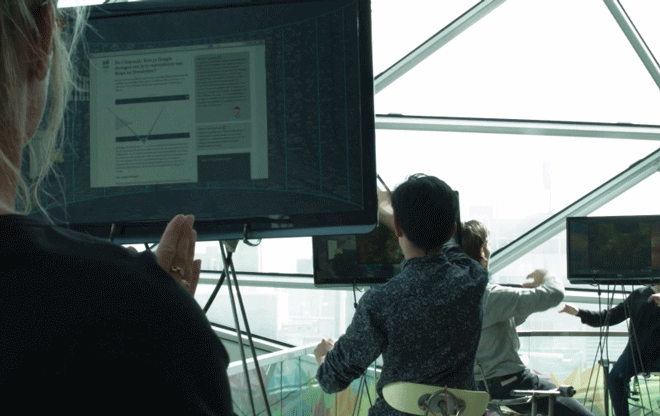About a year ago the media started loudly proclaiming that “sitting is the new smoking.” The sound bite reeked of local nightly news fear-mongering, but there’s science behind it: the "sitting disease," caused by being sedentary for hours at a time, raises your chances of developing cardiovascular disease, diabetes, and even cancer.
Problem is, we need to stay seated to work on computers. Assuming you’re not doing sly at-your-desk workouts like butt clenches, moving a computer mouse around comprises the bulk of physical activity that happens at work. So, reasoned designer Govert Flint, why not amplify that interaction into something that engages the entire body?
In the Dynamic Chair, surfing the web is like attending a new-age Pilates class. Scroll around by shifting your body’s weight from side to side. Sensors in the seat detect the pressure and angle of your tush and communicate that data to three accelerometers that measure that movement on an axis, and translate it into activity on the computer’s screen. To click, kick up your right leg. Sensors will detect that motion too. For the time being, arms and hands are unencumbered, for typing, but Flint imagines plenty of future possibilities there. (That's why the video that accompanies Flint's thesis shows actors using their arms.)
“Western society is so over-organized. I found it odd that we create tech that’s so efficient that it takes over psychical efforts, so we go to fitness centers to create the movements,” says Flint, who is a recent graduate of Eindhoven Design Academy. “We decide to move because we don’t move in our daily life as much.”
To figure out exactly what kind of body movements would work (theoretically, once the sensors are in place, Flint could have programmed the software to interpret any number of gestures) Flint studied dancers at the Scapino Ballet Rotterdam. “They’re aware of movements, and can give more accurate information on what affects movements have on the body,” Flint says. He noticed that when ballerinas jump up, it triggers a jolt of excitement, so the kick-to-click motion can simulate a little bit of that. “My whole quest was about how to release emotions with our daily activities.” Flint also spoke with a physiologist at the ballet who pointed out that human hips weren’t designed to stay rooted in a chair. There’s a lot of cartilage in there that’s meant to allow walking, hence the hip rotations that let users scroll.
Flint has a considerable amount of work ahead to get the Dynamic Chair out of the prototype stage. For one, the movement is largely confined to the lower body. And as of now the device can’t achieve the same accuracy that other motion detection software like Kinect can. But the greatest challenge, really, would be convincing office denizens to use them. A short video imagines office life with Dynamic Chairs instead of ergonomic task chairs. In it, a woman calmly strolls past employee after employee that’s wiggling and kicking around at their computer before she takes a seat in her own Dynamic Chair. No one looks cool. But, given the genesis of the Dynamic Chair, silly might pan out: “It started with more broad research on how to integrate happiness in daily life,” Flint says.
